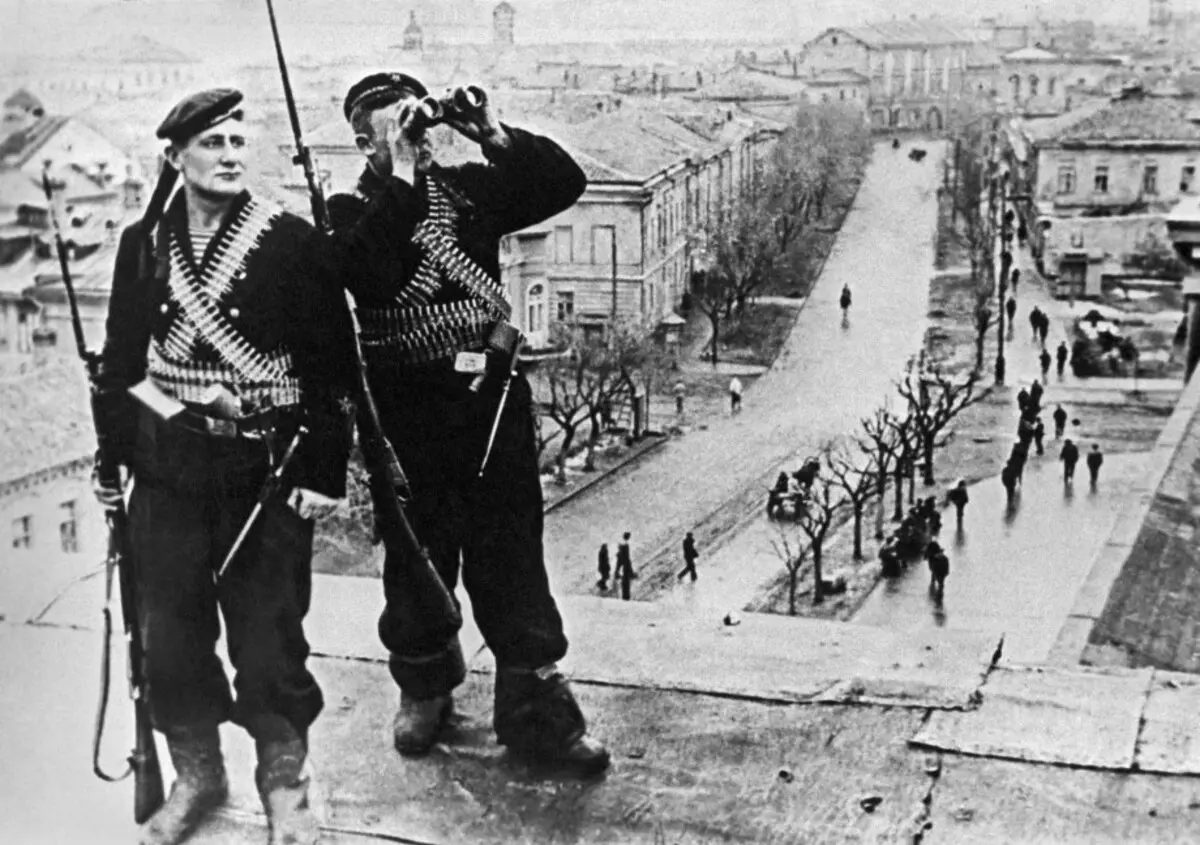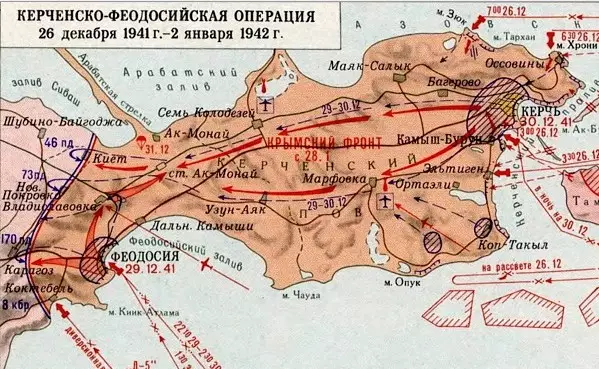
December 31, 1941, the Red Army made a decent gift to the Soviet people. Sovinformbüro reported that the Transcaucasian Front released the two Crimean cities - Kerch and Feodosius. It was reported that as a result of brutal battles. But about the details, about large and bloody losses, about the miscalculations of the Soviet command, the inexperience of the commanders did not mention ...
Fights behind the Crimea began at the end of September 1941. On September 26, parts of the 11th Army of the Wehrmacht under the command of the talented general of Manstein broke through the strengthening of the Perekopsky Isthmus and entered the peninsula. And the Crimea is conveniently protected only at the skeleton. After his fall, the defendant has to retreat to Sevastopol and the Kerch Peninsula. Only there it can be fixed. It happened in the fall of the 41st. Part of the Soviet troops departed to Sevastopol, most of the 51st army towards Ak-monai positions at the Kerch Peninsula. There, in the very narrow place of the peninsula, the Germans and Romanians could be delayed. But unfortunately it did not happen. First of all, according to the fault of the commander of the army of the Colonel-General Fyodor Kuznetsov and aimed at the help of the representative of the march of Marshal Kulika. These two "commander" literally passed comfortable ak-monaist positions, and then Feodosia and Kerch, evacuating the troops to Kuban. The whole Crimea, except Sevastopol, was captured.
The attempt of the Wehrmacht to take Sevastopol with the fly failed. To take the city of Manstein, it was necessary to pull almost all his strength. For the cover of the Kerch Peninsula, he left only one 46th infantry division and several Romanian rock infantry regiments. The Soviet command decided to use this circumstance to apply a response to the forces by the Transcaucasian Front and the Black Sea Fleet.
Why are the Transcaucasian? Yes, because it was fresh parts deployed from Iran, where they before they carried out occupying tasks. On the one hand, these were fresh and full-blooded divisions, but about the experience and "shellation" questions arise. They participated in hostilities in Iran in August 1941. But these were actions against a weak enemy who fought chaotically, spontaneously and unorganized. It played a role. Fighters and commanders of the Transcaucasian front expected the same war against the Germans. But the Wehrmacht and even the Romanian army was a much stronger opponent.
New Year's gift in 1942 - the liberation of Kerch and Feodosia EricDmitry Kozlov
According to the head of the headquarters of Front Fedor Tolbukhina, it was planned to cause simultaneous strikes in three places, but the commander of the front Dmitry Kozlov decided to conduct an operation in two stages: December 26 to plant a landing and take Kerch, after three days it falls around in Feodosia. Initially, the 79th maritime brigade was planned from the ships in Feodosia, and then on the captured bridgeheads of the 345th Rifle Division. But here the troops of Manstein began the assault on Sevastopol, and these units urgently moved there. The landing was determined by the 9th and 63rd mining divisions, equipped mainly by Caucasians and Asians do not know how to swim. Change in such a responsible and complex case of marines on the mountain shooters - a risky step, but time was pressed, and other parts were not available at hand.
The landing of parts of the 51st Army (Lieutenant-General V.N. Lvov), which also entered the Transcaucasian front, on the northeastern coast of the Kerch Peninsula began in the morning of December 26, 1941. Heavy Conditions: Berented a storm at sea, the head of ice was formed at the shore, which prevented the approach of the courts; The air temperature fell to 10-15 degrees below zero. In addition, neither the Black Sea Fleet nor the Azov flotilla had special means to unload heavy equipment and landing for troops on the unequipped coast. For the transfer of troops, small combat ships were used, fishing seinols, bowls and dredgers. In the tug, they dragged fishing lumbies and non-self-propelled barges. During the night transition, the number of detachments collapsed, cables were torn, and many boats in which up to 20 people were stuffed were lost. The landing of the landing began with a delay and not in all scheduled items. It was not possible to achieve suddenness.
New Year's gift in 1942 - the liberation of Kerch and Feodosia EricDelivered to the landing of the soldiers jumped into ice water and Bard to the shore, where they were in anticipation of the next wave of the landing. Many, especially wounded, frozen, since on December 27, the storm strengthened, the movement of the ships for the strait was forbidden and only a day later resumed. Despite opposition from the enemy, Soviet troops managed to seize a number of bridgeheads on both sides of Kerch. As if in a mockery over these incredible efforts of people, a shed after 2 days was to the ice, and the main forces of the 51st army crossed in Kerch literally on foot.
New Year's gift in 1942 - the liberation of Kerch and Feodosia EricManstein first considered the Kerch landings by distracting maneuver, designed to ease the position of the defenders of Sevastopol. He ordered the commander of the 42nd Corps General Speonka to focus all the forces of the 46th Infantry Division and reset the Russians in the sea, and to cover the Feodosia to send 4-Maja, 8 Cavalry Romanian brigades and one German infantry regiment - their latest reserves. The remaining forces of the 11th Army were drawn in brutal battles for Sevastopol: it seemed that the last effort should be taken - and the fortress fell. Therefore, on December 28, the Germans continued to assault.
But on December 29, the ships of the Black Sea Fleet approached the Feodosia and despite the losses, the Germans from the berths moved to the fire from the berths, where the landing began to land. Dropping the suitable Romanian brigades of the troops of the 44th Army (Major General A.N. Pervishin), took the city in the evening. General Swinker learning about the fall of Feodosia, ordered to leave Kerch. The departure of the 46th division more came to the flight, its parts, throwing most of the artillery and military equipment, forced march retreated to Ak-mona and shells (for the self-class deposit, the Count Sponek was devoted to the court of the Military Tribunal and later shot, and the 46th person Infantry Hitler banned to submit to any award).
But then the strangeness began. As I admitted, the manstein in his memoirs was created critical for the Nazis situation: "If the enemy used the benefit of the created position and quickly would chase 46 PD from Kerch, and also hit the Romanians resolutely following from Feodosia, then the situation would be created, hopeless not only For this, the newly emerged area ... the fate of the entire 11th army would have solved. A more decisive opponent could have a rapid breakthrough on Dzhanka to paralyze all the supply of the army ... But the enemy failed to use a favorable moment. Either the command of the enemy did not understand their advantages in this setting, or it did not decide to use them immediately. "

But to the surprise of the Germans, the Army had advancing through Kerch 51st, and the troops of the 44th army from Feodosia were not the main forces to the West, but to the east, towards the 51st army. "The enemy clearly seen himself only his tactical goal - the destruction of our forces on the Kerch Peninsula - and completely missed the operational goal - the intersection of the main life artery of the 11th Army." (Erich von Manstein).
New Year's gift in 1942 - the liberation of Kerch and Feodosia EricBut with a stone man, such miscalculations do not pass in vain. Taking advantage of the delay in the offensive of the Crimean Front, he brought the soldiers of the 46th division to panic to panic to panic, pulled all cash reserves to Ak-monai positions. Strengthened Romanian parts by German soldiers. He drove into the battle of all Namilikov, including the protection of his own headquarters.
The situation demanded the immediate development of active actions, while Manstein did not have time to create strong defense, the weakness of his forces on this site created exceptionally favorable conditions for the development of the offensive. The rate required a speedy goal from Kozlov, as well as strikes into the rear of the Sevastopol group of the enemy. But that, under the pretext of the unpretentiousness of the troops, turned the transition to offensive actions. Its doubts can be understood: during the landing operation, more than half of the troops participating in it were lost - 42 thousand people, of which about 32 thousand killed, frozen and missing. Kozlov reported that the offensive could be appointed no earlier than January 12. Then the offensive period was transferred to the 16th number, but it did not happen, although Kozlov had 181 thousand fighters and officers at the disposal of Kozlov. Even having a triple superiority in the forces, the Soviet generals did not decide on a deep operation and wanted to accumulate more strength.
Yes, our troops have not been able to effectively act in the offensive. Some of the parts were in complete inaction. The bad organization: the connection is only narratively, in the captured ports were not timely delivered air defense facilities and German aviation. Cashlessly bombed them, there was not a single medical institution at the springride, the nearest hospital was in Kuban. The wounded fighters, having received a primary dressing in the regimental sander, were overlooked from the position in Kerch, from there, from there, from the bargoing, they traveled to Novorossiysk.
During this time, the Germans duraly saddled Ak-monaic positions and began to sink them much more problematic. On January 18, they again beat Feodosia. Failure with the seizure of Ak-monaic positions a few months was auctioned by the Crimean catastrophe. But that is another story.
With all the shortcomings and bad organizations, the Kerch-Feodosian landing operation played a role. Germans and Romanians lost 10 thousand soldiers and officers. Significant forces from Sevastopol are drawn, as a result of which the first assault failed. Despite all the disadvantages, shortcomings and bad organization it was one of the first victories of the Red Army. Bloody with heavy losses, but victory. The Red Army only learned to step and win.
